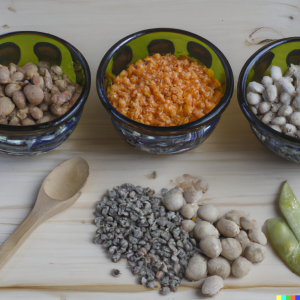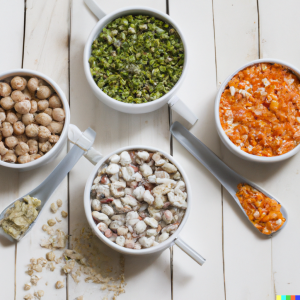
Pulses are often overlooked as an important part of a balanced diet, yet they can provide a wealth of health benefits when eaten regularly. A pulse is a type of edible seed which comes from a pod of a leguminous plant. Common pulses include lentils, beans, chickpeas, peas and various types of edible dried beans.
Nutritional Benefits of Pulses
The nutritional benefits of pulses have been recognized for centuries, and they have been an important part of diets around the world. Pulses are the edible seeds of legumes, including beans, peas, lentils, and chickpeas. They are incredibly nutritious and are an excellent source of plant-based proteins, complex carbohydrates, vitamins, minerals, and dietary fiber.
Pulses are an excellent source of plant-based proteins. Compared to many other plant-based proteins, pulses are relatively high in protein, containing about 8 to 10 grams of protein per 1/2 cup serving. This makes them an ideal substitute for animal proteins and a great way to increase the protein content of vegetarian and vegan diets.
Pulses also provide a variety of essential vitamins and minerals. One half cup of cooked pulses provides about a quarter of the daily recommended value of iron, folic acid, zinc, and magnesium. They are also an excellent source of potassium, which helps to regulate blood pressure and ensure proper muscle and nerve function.
Pulses are also very high in fiber. They contain both soluble and insoluble fiber, which is essential for proper digestion and can help to reduce cholesterol levels. Soluble fiber helps to slow digestion, which can help to keep you feeling full and satisfied for longer. Insoluble fiber helps to add bulk to stools, making them easier to pass.
Pulses are also incredibly versatile and can be incorporated into a variety of dishes. They can be cooked and added to salads, soups, and stews. They can also be ground into flour and used to make breads and pastries. Pulses can also be made into spreads, like hummus, or used to make veggie burgers.
In addition to their nutritional benefits, pulses are an affordable and sustainable source of protein. They are relatively inexpensive when compared to other sources of protein, such as meat, fish, and dairy. They are also a very efficient crop to grow, making them an environmentally-friendly option for those looking to reduce their carbon footprint.
History of Pulses
Pulses are the edible seeds of legumes, a family of plants that includes peas, beans, lentils, and chickpeas. They have been a part of the human diet for thousands of years and were likely first cultivated in the Middle East and the Mediterranean region. Evidence of their consumption can be found in ancient Egyptian tombs, where archaeologists have uncovered pottery containers full of dried lentils.
The Greeks and Romans also consumed pulses, and their consumption spread throughout Europe and Asia as trade routes opened up. In the Middle Ages, pulses were particularly popular among peasant populations, due to their affordability and nutritional value. In fact, in some parts of Europe, pulses were often referred to as “The Bread of the Poor”.
In the 1600s, pulses began to be imported to North America, where they were grown by the colonists and quickly became an important part of the North American diet. During the American Revolutionary War, George Washington requested that American forces not march without lentils, in order to provide the troops with a source of nutrition and sustenance.
Pulses have had a long and varied history, both in Europe and in the New World. They have been used for food, animal feed, and even fuel in some cases. In more recent history, pulses have become increasingly important in global nutrition, as their health benefits have been increasingly recognized.
Today, pulses are found in many types of dishes around the world, from Indian curries to Mexican burritos and falafel.
Cooking with Pulses
Pulses are also incredibly versatile. They can be used in a variety of dishes, from soups and stews to salads and side dishes. They can even be blended into dips or spread on toast and crackers. The possibilities are endless.
When cooking with pulses, it is important to remember that each type of pulse has unique characteristics and will require different cooking techniques. Beans, for example, should be soaked overnight before cooking, whereas lentils and split peas do not need to be soaked. In addition, different types of pulses may require different cooking times and amounts of liquid, so it is important to refer to specific recipes or cooking guides when preparing meals.
When cooking with pulses, it is important to remember to season them properly. Adding spices and herbs will not only enhance their flavor, but also add nutrition and antioxidants. Popular spices and herbs include turmeric, cumin, garlic, chili powder, coriander, and bay leaves.
To get the most out of pulses, it is important to cook them in a healthy way. This means avoiding frying them in oil and instead, boiling, steaming, or mashing them. Also, when combining pulses with other ingredients, it is important to use the right ratio. For example, when making a dish like lentil curry, it is important to make sure the lentils are cooked in the right amount of liquid and that the spices are balanced.
Finally, it is important to remember to store pulses properly. They should be kept in an airtight container in a cool, dry place. Additionally, pulses should be cooked within a few days of purchase to ensure their maximum nutritional value.

Clinical Trials on Pulses
Pulses are known to be beneficial for reducing the risk of diabetes, heart disease, and metabolic syndrome. In a large clinical study, people who ate more than one serving of pulses per day had a significantly lower risk of developing type 2 diabetes than those who ate no pulses. Similarly, in a 10-year study, people who ate more than three servings of pulses per day had a 22 percent lower risk of cardiovascular disease than those who ate no pulses. Additionally, pulses have been shown to help lower cholesterol levels and reduce the risk of metabolic syndrome.
Another potential benefit of pulses is their ability to aid in weight loss and management. Studies have shown that pulses can help to increase satiety and reduce hunger levels, making it easier to stick to a healthy diet. Additionally, pulses have a low glycemic index, meaning that they don’t cause a spike in blood sugar levels. This makes them an ideal food for those looking to lose weight or manage their blood sugar levels.
Pulses have also been studied for their potential role in cancer prevention. Studies have found that frequent consumption of pulses can reduce the risk of colorectal cancer, as well as certain types of breast cancer. Furthermore, pulses are rich in antioxidants, which can help reduce oxidative damage, one of the main causes of cancer.